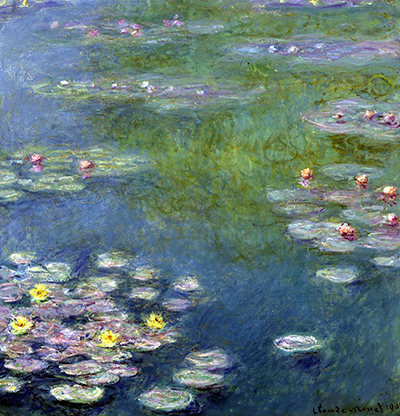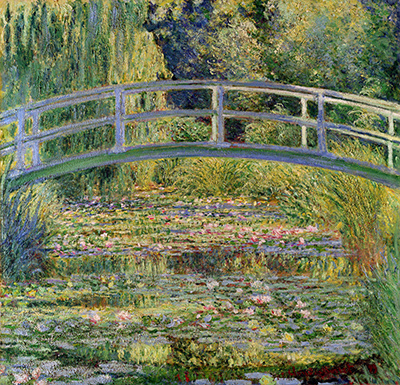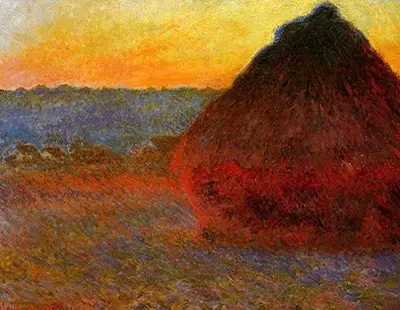Here, he changed the space encompassing his home into lovely, oriental-propelled gardens, finish with beautiful flowers and a lake enhanced with a Japanese extension.
The beautiful green footbridge shows the subject of some of Monet's most outstanding pieces, consisting of The Japanese Bridge (The Water-Lily Pond) from 1899.
Notwithstanding catching the straightforward polish of the sunlit structure, the part likewise puts concentrate on his garden's foliage, including sobbing willow trees, lavish lavender, and coasting water lilies.
Water Lilies Series
Monet's Water Lilies arrangement is maybe his most renowned work. Made out of around 250 oil artworks, Monet made and ordered this accumulation amid the most recent 30 years of his life. Regularly painted en plein air ("outside"), the canvases portray distinctive scenes from his garden, with an emphasis on shifts in light, occasional changes, and variations in shading.
Given the creative consideration Monet provided for his water lilies, it is nothing unexpected that, even over his most appreciated canvases, he esteemed his flowers. Claude Monet once said his garden is the most beautiful masterpieces.
The works—fascinating colouration and strange romantic mood utilized by Claude Monet have plainly been in the illustrations painted in Giverny.
In these canvases it is the environment, more than the particularities of these paintings that are Monet's subject; structures and scaffolds are less unmistakable than the throbbing brushstrokes that offer volume to the light-filled haze and fog. This continued with his series of Haystacks in Giverny.
Haystacks Series
As apparent in his Water Lilies arrangement, Monet was hypnotized by natural light and its belongings. In his Haystacks series, the craftsman presents 25 investigations of daylight's stylish effect on packs of developed wheat, oats, and grain.
The artworks were finished at various focuses for the day and year and amid different climate conditions. This ponders run in setting finishes in pieces that are comparable in topic and organization yet fluctuate generally in shading and tone.
Monet's Further Studies of Light London Houses Of Parliament (The Sun Shining Through the Fog) 1904 This regard for changing light is additionally evident in Monet's works of art of Parliament. Propelled by excursions to London from 1899 through 1901, the arrangement of 25 artworks delineate the Palace of Westminster as observed from a moment floor patio of St. Thomas Hospital. In each piece, Parliament is depicted as a shadowy outline. Instead of concentrating on the points of interest of the royal residence itself, Monet selected to focus on the shades of the sky and its beautiful reflections on the River Thames. Maybe it is this dark way to deal with a tonality that incited Monet to admit that colour is his day-long fixation, satisfaction, and torment. Rouen Cathedral Series Finished in the 1890s, Monet's Rouen Cathedral arrangement grandstands more than 30 works of art of a gothic church in Rouen, France. The lavish reliefs included on the house of prayer's façade result in a costly system of shadows and features that without a doubt pulled in Monet. Like his Haystacks and Parliament arrangement, Monet's accumulation of house of prayer ponders passes on the craftsman's persisting enthusiasm for catching changing impressions of light. Not at all like his different delineations, notwithstanding, had his Rouen Cathedral examinations put accentuation on the structure itself— not on natural highlights like the sky or waterways. The second and last of the underlying themes Monet sought after was the canals and palaces of Venice. Monet started this arrangement in 1908 and proceeded in 1909, in spite of the fact that he took a shot at these subjects at Giverny until 1912. Venice was a perfect Impressionist subject, yet the light, water, development, engineering, and appearance in the water are more summed up in these works than the particular climate impacts of the bundle and house of God arrangement. Some of the Locations Frequently Used By Claude Monet during His Career. While leaving in Giverny, Claude Monet took time in 1899 through to 1901 to visit London where he painted some of the famous paintings that make Monet who he is among the art lovers. During his stay in London, Monet drew House of Parliament 1900-1901 that depicts his skills very well. While in Argenteuil, Claude Monet also drew some of his famous portraits; here are some of the drawings the renowned artist drew while in Argenteuil Woman with a Parasol A representation of Madame Monet and their young child, Woman with a Parasol brought in 1875, was painted in Argenteuil, where Monet and his family stayed from 1872 through 1878. With enlivened brushstrokes and lively composition, the work of art was likely finished outside. Despite the fact that his better half—clad in a desolate outfit and holding a genuinely green parasol—is the point of convergence of the piece, her surroundings likewise assume a noticeable part in the drawing. Monet's interest in the everyday world is especially evident in his treatment of the grass and blossoms, which are carefully dappled with daylight and shadows. Monet once explained that richness he achieves comes from nature, he went ahead to state nature is his primary source of inspiration. Poppy Field in Argenteuil Similar to Woman with a Parasol, this painting created in 1873 depicts Monet's better half and child as they explore the outside. This piece likewise shows Monet's enthusiasm for nature, as apparent in the noticeable field of poppies and concentrate on the retreating scene. Moreover, Poppy Field in Argenteuil shows a vivid inclination toward including "pops" of red in a structure, which Impressionist craftsmen frequently utilized. The Saint-Lazare Station In 1877, Monet created The Saint-Lazare Station, a piece that catches the buzzing about of a bustling Parisian train station. As a significant portion of his composition, this gem passes on an emphasis on light, however development—especially in the trains' surging steam—additionally conspicuously includes. This depiction denotes a captivating movement in the craftsman's profession, as it brought the urban scene into his assemblage of work and in this way raised the craftsman to a painter of present-day life—a title he held for the rest of his vocation.





